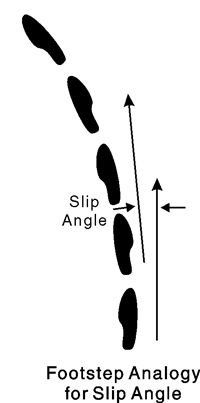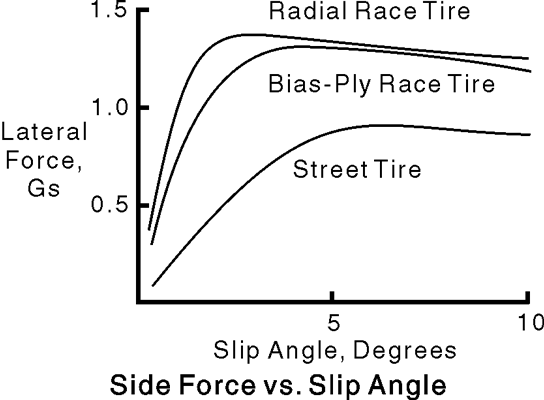INSIDE
RACING
T E C H N O L O G Y
IRT Home
IRT Home
News Page
Contents Page
Newsletter &
Books
email Paul
Tire Basics: Part 1
I published this in my newsletter several months ago. A guy I know who just went to work for a tire company emailed me that this article summed up six months of training he received from his new employer.
Tire Basics
Tires are arguably the most complicated and useful device man makes. We'd all be traveling on rails if it weren't for tires. Without tires we wouldn't be able to live more than walking distance from a rail line. That would be a different world!
Without rubber tires there is no way for a vehicle to make a turn at any speed above a crawl. Those horse-drawn carts of a hundred years ago turned corners because the horse pulled them around the corner. The wood or metal tires on the early horseless carriages generated only enough lateral force to turn the vehicle at very low speeds. The ride was bone-jarring.
A modern pneumatic tire is a complicated composite construction of strong, light polymer fibers in a matrix made up of a carbon-reinforced mixture of elastomeric polymers--rubber. Specialized adhesives help bond rubber and reinforcing cords into a light, doughnut-shaped structure called a carcass. The tread area of a radial-tire carcass is reinforced with a number of polymer or steel belts. A flat band of rubber that forms the traction surface is bonded onto the carcass with heat and pressure. Two steel wire hoops connected to the tread area by relatively thin sidewalls clamp the tire onto the wheel.
The result is a durable, inexpensive device that allows us to operate convenient, safe personal vehicles resulting in complete individual mobility. So how have the tire companies managed to turn this amazing product into an unappreciated, ugly, smelly commodity?
An Airplane Is Simple
We think of an airplane as a complicated device that's difficult to manufacture and maintain. Actually, every part of an airplane is uniquely defined and indentified with a part number, detail and assembly drawings, material specifications, and manufacturing instructions that insure every unit is made exactly the same. Any vendor with the necessary machinery and skills can make that part and it will be just like all the other units with the same part number made by all the other qualified suppliers.
An airplane if the finished assembly of all the specified
parts. That plane can be inspected at various points during assembly
and corrections and repairs are an expected part of the manufacturing
process. A plane in service undergoes constant inspections, repairs,
overhauls, and upgrades.
Take a steel bolt for a simple example. Any bolt can be inspected
and measured to determine its exact dimensions. Analyze a small
piece of the metal and you can find out the presence and amount
of each element. Inspect 10 bolts and you can estimate the manufacturing
tolerances. Test a couple of bolts to failure and you know the
strength-in pure tensile stress or in fatigue stress (bending
back and forth).
A pnuematic tire is much more complicated. Compared to a bolt, analysis of a piece of a finished tire doesn't reveal much information. The processing time under heat and pressure converts many component materials in the original recipe into different molecules or the same molecules connected in different ways. The individual elements-carbon, hydrogen, oxygen, nitrogen, silicon, iron-are still there. But many of the material components you find in a finished tire have changed during the manufacturing process.
A finished tire is bonded together into one unit and any meaningful inspection destroys that tire. Truck and airplane tires are X-rayed to make sure parts aren't left out and there are no unbonded areas, but how well the whole thing is stuck together is difficult to quantify. The quality of every tire depends on the precision and repeatability of the processes and the motivation and skills of the humans involved.
The point here is that many different companies can and do make an airplane or a computer but only a few companies can make tires. The tire is an extremely important, complicated, and useful device.
Secrecy and Paranoia
Tires start with specialized raw materials: oils, accelerants, reinforcing fillers (carbon black and/or silica), synthetic and natural rubbers, and synthetic fibers spun into threads that are twisted into cords and then coated with an adhesive. Most of these components undergo processes during manufacturing that are proprietary to a specific manufacturer and are guarded with a fervent secrecy that makes the U.S. nuclear bomb program look like an internet chat room.
Here's a story that emphasizes secrecy among tire manufacturers. A European tire factory caught fire and the blaze got quickly out of control. The local fire department responded but was stopped by locked gates. "Let us in and we'll put out the fire," pleaded the Fire Chief. "We can save some of your equipment at least."
"You can't come in," was the reply. "Let it burn ."
Supposedly there are only a few people at each major manufacturer-Goodyear, Michelin, Bridgestone-who actually know the recipes and processes. Most employees at these companies only know what's going on with their small area or process. The materials and processes are so complicated that most development is trial and error. I had a tire guy tell me, when some big bug splats against his windshield, he always wants to stop and scrape off so he can take it to work and see if it might help some compound or process.
How Does It Do That?
A tire turns a corner because it's an elastic system that grips the road. With the vehicle's steering wheel pointed straight ahead the tire tread rotates around the wheel slamming down onto the road surface when it gets to the contact patch. Turning the steering wheel changes the directional heading of the tire. While the car is still going in the old direction the tread rotating into the leading edge of the contact patch comes down onto the road surface and takes a grip a small amount toward the new heading. The flexible, elastic nature of the tire allows the majority of the contact patch to continue in the old direction while the leading edge of contact patch rotates onto the road heading in a new direction.
As the weight of the car comes onto the tread that's headed in the new direction that part of the patch grips the road surface and forces the wheel to move that way too. One way to visualize this is to think about what happens when you're walking. Each footprint is straight ahead until you want to change direction. You turn your foot in the direction you want to go and when your weight comes on that foot you're headed in a new direction. If you turn each foot through the same angle before you set it down the result is a smooth arc.

As long as the steering wheel is turned away from straight ahead, each new increment of tread coming down onto the road surface claws the car to a new heading. The difference between where the car is headed and where the tire is pointed is called the slip angle-a poor label but we're stuck with it. There isn't really any slipping or sliding going on until very high slip angles.

Tires of similar construction and rubber compound generate a characteristic curve when you plot slip angle vs. the lateral force produced. These lateral (to the side) forces generated by the front tires act on the chassis and turn the car. If the rear of the car were on casters it would swing out but the rear tire heading is fixed by the rear suspension and they assume a slip angle and produce lateral grip also. At small slip angles a unit of steering gives a unit of force. At larger slip angles some of the contact patch is sliding and the curves level off. At high slip angles most of the tire is sliding and more steering input doesn't make much difference.
Effect of Air Pressure
A pneumatic tire is essentially a tube filled with air. The higher the internal air pressure the stiffer the tube. As pointed out above steering input causes a tire to twist on its contact patch causing the front edge of that patch to claw the car in a new direction. A stiffer tire reacts more quickly to a change in steering input. A lower pressure tire absorbs more road irregularities but is less responsive to steering.
Internal pressure also affects the size of the contact patch. As a vehicle's weight comes on a tire the tire deflects in several ways. The thickness of the tread rubber thins slightly depending on the spring rate of the rubber compound but the air volume of the tire takes up most of the deflection and a contact patch forms. The weight on the tire and the tire's internal pressure determines the size of the contact patch. A tire inflated to 30 pounds per square inch (psi) loaded with 300 pounds (lb) flattens to a contact patch of 10 square inches (in2).
In the area of the contact patch the radius of the tire is smaller than in the rest of the tire. You can actually visualize the weight of the car bearing on the wheel and that wheel hanging from the tire sidewall opposite the contact patch. That means the sidewalls curve more in the contact patch area and are straighter 180 degrees from there.
Contact patch area goes up as the weight on the tire increases. A larger contact patch means a longer contact patch because the tire width is fixed. And a longer contact patch makes the tread deflect more going into and coming out of the contact patch. These larger deflections increase bending in the tread causing bigger fatigue stresses in the cords that hold the tread together.
Deformation of the contact patch also generates heat. If you
look at the tread surface of a tire you'll notice it's slightly
rounded. When that rounded tread gets to the contact patch it
tries to flatten out but its basic shape prevents it from flattening
perfectly. The difference is squirm. Squirm causes the cords
and rubber in the tire to rub together producing heat.
All these deformation modes create heat. Higher vehicle speeds
work the tires harder causing more squirm and more fatigue stress.
And more heat.
The second part of this article will appear next week.
Questions? Comments? Leave an email using the link at the top left.